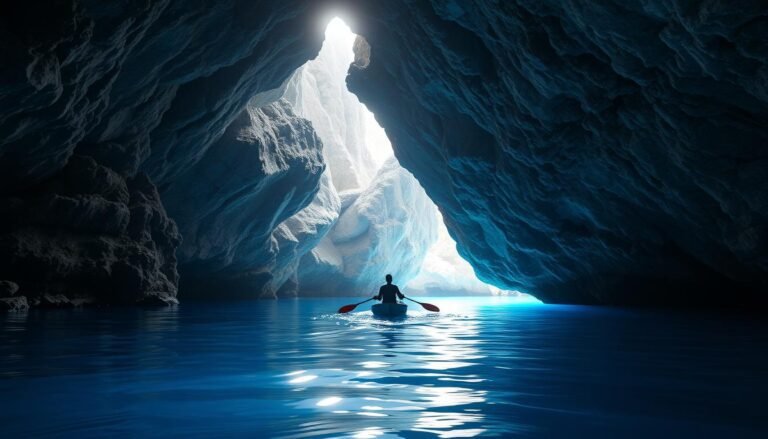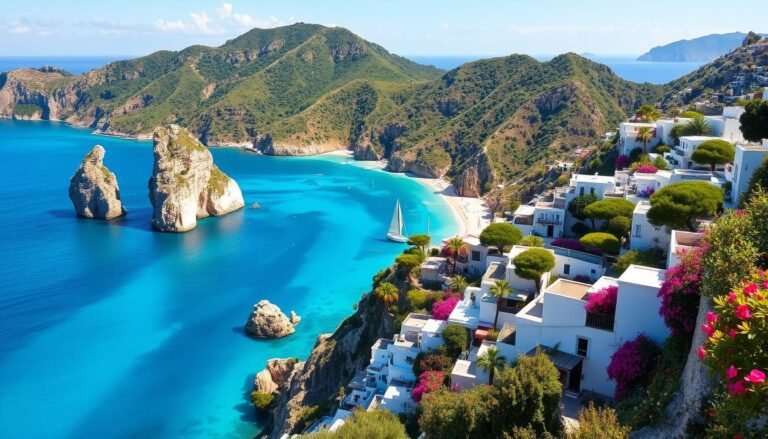As I step into the heart of Banff National Park, the stunning vision of Lake Louise takes my breath away. This glacier-fed gem nestled in the Canadian Rockies is a true natural wonder, captivating visitors from around the world with its vibrant turquoise waters and awe-inspiring mountain backdrop. From world-class skiing and hiking to serene canoeing and ice skating, Lake Louise offers an unparalleled array of outdoor adventures, making it a must-visit destination for anyone exploring the majestic Canadian Rockies.
Key Takeaways
- Lake Louise is a breathtaking alpine lake located in Banff National Park, Canada’s oldest national park
- The lake is renowned for its vibrant turquoise waters, created by rock flour carried by glacial meltwater
- Visitors can enjoy a range of outdoor activities, including world-class skiing, hiking, canoeing, and stand-up paddleboarding
- The Fairmont Chateau Lake Louise overlooks the lake and offers luxury accommodations
- Lake Louise is a year-round destination, with peak visitation during the summer months
Where is Lake Louise Located?
Nestled in the heart of the Canadian Rockies, Lake Louise is a breathtaking glacial lake located within Banff National Park, Canada’s oldest national park. This stunning natural wonder sits at an elevation of 1,750 meters (5,740 feet), making it one of the highest permanent settlements in the country.
Easily Accessible via the Trans-Canada Highway
Lake Louise is easily accessible via the Trans-Canada Highway, a major interprovincial highway that traverses the Canadian Rockies. The lake is situated just off the Trans-Canada Highway, approximately 180 kilometers (110 miles) west of the city of Calgary. The southern terminus of the Icefields Parkway, a scenic highway that winds through the Canadian Rockies, is also located just north of the Lake Louise community.
The Lake Louise area is divided into two distinct sections: the larger community of Lake Louise Village, which is directly accessible from the Trans-Canada Highway, and the Upper Lake Louise area, which is home to the famous Fairmont Chateau Lake Louise and a variety of outdoor recreational opportunities. Whether you’re looking to explore the stunning turquoise waters of the lake itself or immerse yourself in the rich history and natural beauty of Banff National Park, Lake Louise is a must-visit destination in the heart of the Canadian Rockies.

lake louise: A Glacial Wonder
Nestled amidst the majestic Canadian Rockies, Lake Louise stands as a true natural marvel – a stunning turquoise lake formed by the relentless work of glaciers. The lake’s enchanting hue is a testament to the remarkable geological processes that have shaped this alpine wonderland over time.
Glacial Meltwater Creates the Turquoise Gem
Lake Louise was formed when a dam of glacial debris caused the glacial meltwater to back up, creating the captivating turquoise lake we see today. The lake’s primary water source is the mighty Victoria Glacier, which towers above the lake. As this glacier slowly melts, the glacial meltwater flows into Lake Louise, giving rise to its distinctive and vibrant color.
The glacial melt carries a fine sediment known as “rock flour” into the lake, which reflects the sunlight and creates the breathtaking turquoise hue. This unique phenomenon is what makes Lake Louise a true glacial lake – a natural masterpiece sculpted by the relentless forces of ice and water over centuries.
The lake’s outlet flows into the beautiful Bow River, which winds its way through the heart of Banff National Park, adding to the region’s natural splendor.
The Mesmerizing Hues of Lake Louise
Lake Louise is renowned for its breathtaking turquoise color, a result of the glacial meltwater that feeds the lake each spring. This meltwater is rich in glacial rock flour, a fine silt created by the erosion of rocks as the water flows from the surrounding glaciers. When the sunlight hits the rock silt, it creates the vivid turquoise color that has made Lake Louise a must-visit destination.
The lake’s color is most vibrant during the spring, when the glacial erosion process is at its peak. As the snow melts and the glaciers release their meltwater, the lake becomes a canvas of stunning turquoise hues, captivating visitors from around the world. The interplay of sunlight, glacial meltwater, and rock flour creates a mesmerizing display, making Lake Louise a true natural wonder.

Factors like cloud cover, air quality, and the presence of minerals or algae can influence the appearance of the water, causing variations in blue shades in lakes. The selective light absorption and reflection of blue light also contribute to the vivid colors, making Lake Louise a true feast for the eyes.
Exploring the Rich History of Lake Louise
Lake Louise’s history dates back thousands of years, with the Stoney-Nakoda First Nations people originally calling it “Ho-run-num-nay,” meaning “the Lake of Little Fishes.” In the late 19th century, the Canadian Pacific Railway Company established a settlement at the lake and constructed the Chateau Lake Louise, a modest two-bedroom log cabin that offered visitors a chance to escape the industrial world and immerse themselves in nature.
Over the years, the Chateau was expanded and improved, and Lake Louise became a popular tourist destination, drawing in a host of famous visitors, including royalty, Hollywood stars, and renowned mountaineers. In 1884, the lake was renamed in honor of Princess Louise, daughter of Queen Victoria and wife of the Governor-General of Canada.
Lake Louise played a significant role in the birth of Canadian mountaineering, attracting notable figures like King Edward VIII, Queen Elizabeth II, Prince Rainier of Monaco, Alfred Hitchcock, Douglas Fairbanks, and Marilyn Monroe. In 1984, Banff National Park and Lake Louise were designated as a UNESCO World Heritage Site, recognizing their outstanding natural and cultural significance.

Today, Lake Louise remains one of Canada’s most iconic natural landmarks, attracting millions of visitors each year who come to experience its stunning turquoise waters, glacial landscapes, and rich history. Whether you’re a mountaineering enthusiast, a nature lover, or simply seeking a breathtaking escape, Lake Louise offers a truly unforgettable experience.
Incredible Outdoor Adventures at Lake Louise
Lake Louise is a true outdoor enthusiast’s paradise, offering a wide range of exciting activities and experiences throughout the year. This stunning glacial lake, nestled within Banff National Park, is renowned for its world-class skiing, captivating hiking trails, and tranquil waters perfect for canoeing, kayaking, and stand-up paddleboarding.
World-Class Skiing and Hiking Trails
During the winter months, the Lake Louise Ski Resort provides spectacular trails for skiers of all levels, from beginners to experts. With three Rocky Mountain ski resorts in the Banff area, visitors can enjoy a variety of winter sports, including snowshoeing, skating, and cross-country skiing.
In the summer, the hiking opportunities around Lake Louise are truly breathtaking. The popular Lake Agnes Teahouse hike, the Plain of Six Glaciers Teahouse hike, and the Bow Glacier Falls hike offer stunning views of mountain peaks, glaciers, and alpine lakes. These trails are accessible from late June to early October, providing visitors with a chance to immerse themselves in the stunning natural beauty of Banff National Park.
Canoeing, Kayaking, and Stand Up Paddleboarding on Turquoise Waters
For a more serene and tranquil experience, the turquoise waters of Lake Louise are perfect for canoeing, kayaking, and stand-up paddleboarding. Visitors can rent equipment from the Fairmont Chateau Lake Louise and glide across the mirror-like surface, marveling at the surrounding mountain peaks and glaciers. The resort also offers a variety of events and celebrations, including an Afternoon Tea, Ice Bar, and Ice Rink, making it a truly unique and unforgettable destination.

Nearby Attractions and Events in Banff National Park
As I explore the stunning landscapes surrounding Lake Louise, I’m delighted to discover the wealth of natural wonders and cultural attractions that await just beyond this glacial wonder. One of the must-visit destinations in the area is the Banff Hot Springs, a historic thermal spring that has drawn visitors to the region for over a century. Soaking in the soothing mineral-rich waters while taking in the breathtaking Rocky Mountain vistas is an experience like no other.
Banff Hot Springs and Exciting Festivals
In addition to the Banff Hot Springs, the town of Banff hosts a variety of exciting events and festivals throughout the year that showcase the region’s rich heritage and vibrant culture. The Banff Centre Mountain Film and Book Festival, a celebration of mountain adventures, is a must-attend event for outdoor enthusiasts. As the summer arrives, the lively Canada Day celebrations on July 1st bring the community together with music, food, and festive activities. And for whisky connoisseurs, the Banff Whiskey Experience in September is a true highlight, offering the chance to sample and learn about the finest Canadian whiskies.
With so much to see and do in the Banff National Park region, visitors to Lake Louise will find an abundance of opportunities to create unforgettable memories and immerse themselves in the natural and cultural wonders of this remarkable destination.




